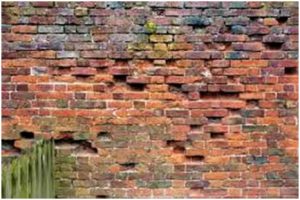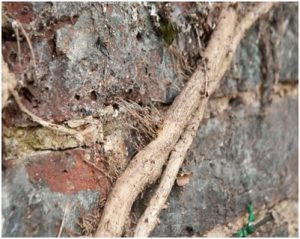Does your masonry building have fungi or plant growth? Do you ever wonder what these biological growths can do to your masonry building? If your answer to any of these questions is yes, then this is the article for you. Biological growths can come in many different forms (i.e. algae, fungi, and higher plants) and it is extremely tough to prevent these things because biological growth on masonry is inevitable. This article is going to inform you on not only what these growths can do to your building but the proper things to think about when deciding how to act on the matter.
Surface roughness such as masonry encourages biological attachment, while high porosity retains moisture necessary for organisms to survive. Surfaces that are not very porous such as granite, tend not to see a lot of biological growths. The most common types of biological growth found on masonry includes algae, fungi, mosses and higher plants (i.e. grasses, bushes and trees). Biological growth on a building’s exterior is inevitable, some forms are just aesthetically displeasing while others can cause concerning damage to masonry.

Fungi growth on masonry brick building
Fungi is one of the top concerns for masonry buildings in New England based on the climate it endures throughout the year. Although not extremely problematic for your structure, aesthetically, it takes away from your building. Now in saying that, an excess of fungi buildup can ultimately be an indicator that there is something wrong with the structure in that area. For example, a buildup of fungi could tell you that ineffective water runoff or damaged pointing is in that area. If water is not properly exiting the affected area as it should then this moisture will build up overtime having nowhere to escape. This results in an excess of fungi, discolored portions of masonry and flaking/ cracked masonry.
Another huge concern for a structure is plant growth (i.e. vines, bushes, trees) which might not seem concerning to the eye, but a closer look will show you how damaging this can be. Lots of plants can grow around and even up your structure which is inevitable, but what you need to be aware of is the root of it all. Plants have tiny root hairs that seek out opportunity wherever they can. Once an opening is found, woody plants can open joints and even dislodge stones. Once the root is into the joint, they then can crack that stone or brick as the root expands allowing water to get in, ultimately wearing the stone away and feeding more nutrients to the root. Once a root is into the structure and the cold New England winter comes, stone will crack when the root/water freezes. Aesthetically these vines or plants may enhance your buildings appearance but structurally will do a lot of damage if not caught and treated properly.

Root growth on a brick building
So, what do you do if you find any of these growths on your building? First, inspect the affected area, if you can tell that the building has plant growth or is discolored check the surroundings there may be a crack, dislodged masonry or even open joints. Secondly, if there are not any of these problems then the discoloration and/or plant growth can just be from the moisture or environment surrounding the building. Lastly, if there is cracking, dislodged masonry or extreme fungi build up then there is a high chance of a structural problem within the masonry and a quality repair is needed to keep that building from deteriorating further. Give us a call, we have the expertise to not only inform you of your best options but to walk you through the process in repairing your building.
Whether that building needs masonry replaced, concrete repaired, joints fixed, repointing, acid washing, or waterproofing Hascall & Hall offers high quality work, with competitive pricing and experts that will treat you right.
